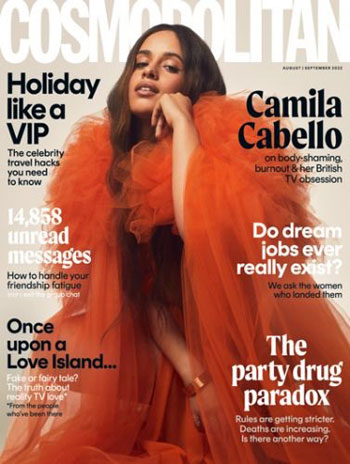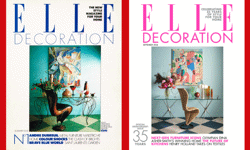
Perusing the cover of the August issue, I was impressed to find a varied and thoughtful mix of articles. Coverlines included ‘14,858 unread messages: how to handle your friendship fatigue’; ‘The party drug paradox: rules are getting stricter. Deaths are increasing. Is there a better way’; ‘Camila Cabello on body shaming, burnout and her British TV obsession’ and ‘Do dream jobs ever really exist? We ask the women who landed them.’
I had been expecting something slightly raunchier, but there was not a single mention of ‘sex’ anywhere on the cover.
At 138,243, its print circulation is well down on what it used to be (Jan-June 2000: 450,057), but it’s hardly alone in that regard and the figures that count most – paid-for copies – are heading in the right direction.
Whilst its latest ABC showed a year-on-year drop of 21% in headline circulation, the drop is accounted for by the shedding of almost 50k free copies. Newsstand copies were marginally down, but subscriptions were substantially up (28%).

Print remains a key pillar and its recent redesign was its biggest in a decade. According to Claire Hodgson, editor-in-chief, “print is so important to the brand; it’s our shop window and has a huge halo effect on the rest of what we do.”
But print only tells part of the story. After taking some time to find its digital feet, the appointment of Claire as digital editor in 2015 was a signal of intent. Under her leadership, says Hearst UK, Cosmopolitan’s digital audience has quadrupled and its social following is now over 5m.
She was promoted to digital editorial director in 2018 and then to editor-in-chief in 2019.
James Wildman, Hearst UK’s CEO at the time, said: “Claire is one of the brightest brains in the business and I am delighted to appoint such a forward-thinking, cultural architect in this high-profile role.”
The title has a spring in its step and in Claire, they’ve found an eloquent brand ambassador.
Talking with her in a recent episode of The InPublishing Podcast, the Cosmopolitan approach would appear to be underpinned by three pillars:
1. A belief in genuine multi-platform publishing
Claire sees each of the platforms Cosmo publishes to as “connected but separate”. Long gone are the days when the various platforms were simply used as conduits to amplify content from the print magazine. The different platform teams, whilst adhering to Cosmo brand values, have a license to grow their channel, to act, in effect, as pureplays. She sees each of the channels as “mini-brands” in their own right. This involves a willingness to experiment. This autumn should see the launch of
‘Summerverse’, Cosmo’s first venture onto the metaverse. It’s based on the premise of it being summer all year round – “a lot of fun, so much opportunity”.
2. Deep audience engagement
“Audience underpins everything,” says Claire; “You have to be your audience’s best friend.” Part of this is simply being where they are: “you have to be on the platforms they are using and offering relevant content on those platforms.” Part is being inclusive – “we are for everyone and everyone is welcome here”. With not insignificant numbers of Cosmo readers being gender-fluid and identifying as non-binary (in fact, there is no such thing any more as a “typical” Cosmo reader, she says) and so much division and exclusion in the world, she wants Cosmo to be a “safe space”.
Another part is taking a campaigning stance on issues that impact its audience, such as domestic abuse, the non-consensual sharing of images and the deep fake porn epidemic.
3. A considered approach
Growth is a target for all Cosmo teams, but not at any cost. Authenticity is so important. “Our audience is increasingly swayed by sincerity in the brands they engage with and they just don’t have time for performative behaviour and they can smell it a mile off,” says Claire.
She discourages clickbait: “We are not a brand that rewards or incentivises our writers on traffic performance. The long piece which gets less traffic is still as important as the short piece, if not more so.”
An example of this approach was how it treated the death of Caroline Flack in 2020. In the immediate aftermath, there had been much lurid speculation on the internet about the exact circumstances of her death. Flack had been a regular and respected presence in the magazine and Claire took the decision that Cosmopolitan would not indulge in the media frenzy.
Yes, it would have driven traffic, but she saw it as not fitting with Cosmo’s brand values, which she characterises as “fair, considered and fact-checked”.
Cosmopolitan has a responsibility to talk about the serious, sometimes dark, issues affecting its readers, but, equally, says Claire, to tell them all about the latest must-have mascara for a great Saturday night out.
Every publishing brand looks for that sweet spot, where it knows what it stands for, what its audience wants and has found the right formula for delivering it at scale.
Cosmopolitan UK seems to have found that spot and, at 50, to be comfortable in its own skin.

You can hear Claire Hodgson being interviewed by James Evelegh on a recent episode of The InPublishing Podcast, which was sponsored by Air Business, a leading supplier of distribution and subscription management services.
This article was first published in InPublishing magazine. If you would like to be added to the free mailing list to receive the magazine, please register here.












